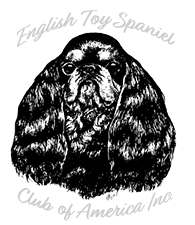Neck, Topline, Body and Tail
The neck on an English Toy is moderate in length and nicely arched. The body is short, compact, square and deep on cobby lines with a broad back. The breed should be sturdy of frame with good rib and deep brisket. The English Toy tail is docked to 2 to 4 inches in length and carried at or just slightly above the level of the back. The set of the tail is at the back’s level. Many are born with a shorter or screw tail, which is acceptable. The feathering on the tail should be silky and from 3 to 4 inches in length, constituting a marked “flag” of a square shape. The tail and its carriage is an index of the breed’s attitude and character.
The Cavalier neck is fairly long, without throatiness, and muscled enough to form a slight arch at the crest. The body is short-coupled with ribs well sprung but not barreled. The chest is moderately deep, extending to elbows. Slightly less body at the flank than at the last rib but with no tucked up appearance. The Cavalier tail is well set on, carried happily but never much above the level of the back and in constant characteristic motion when the dog is in action. Docking is optional, but if docked, no more than one-third is to be removed.
The topline on both breeds is level.
Coat and Colors
The English Toy is profusely coated, having heavy fringing on the ears, body and chest, and with flowing feathering on both the front and hind legs, and feathering on the feet. The coat is straight or only slightly wavy with a silken, glossy texture. Over-trimming of the body, feet or tail fringes should be penalized.
The Cavalier coat is of moderate length, silky and free from curl. A slight wave is permissible. Feathering on ears, chest, legs and tail should be long, and the feathering on the feet is a feature of the breed. No trimming of the dog is permitted. The standard clearly states that specimens whose coat has been altered by trimming, clipping or any other artificial means shall be so severely penalized as to be effectively eliminated from competition.
Blenheim. The Blenheim color for both breeds consists of pearly white ground with deep red or chestnut markings. The English Toy standard states it is preferable that there be red markings around both eyes. The Cavalier standard states a clear pearly white ground and calls for the color to be evenly spaced on the head surrounding both eyes.
Prince Charles or Tricolor. For the English Toy, the black, white and tan color pattern is called Prince Charles, whereas this pattern is called Tricolor on the Cavalier. Both standards read the same, calling for a pearly white ground with evenly spaced black patches, solid black ears and black face markings. The English Toy states it is preferable that there be black markings around both eyes. The Cavalier standard states the pearly white ground be clear and the color evenly spaced on the head and surrounding both eyes. Both standards call for rich tan markings over the eyes, inside the ears and under the tail. The English Toy standard calls for rich color on the face. The Cavalier standard specifically calls for rich tan on the cheeks.
King Charles or Black and Tan. The black with mahogany tan markings for the English Toy is called the King Charles. The same color pattern for the Cavalier is called the Black and Tan. Both standards read much the same, with the exception of the presence of a small white chest patch about the size of a quarter, or a few white hairs on the chest. This is not to be penalized on the English Toy, but any white marks on a Cavalier are a fault.
Ruby. The Ruby color for both breeds is a rich mahogany red. The English Toy allows for the presence of a small white chest patch about the size of a quarter or a few white hairs on the chest. For the Cavalier, any white marks are a fault.
